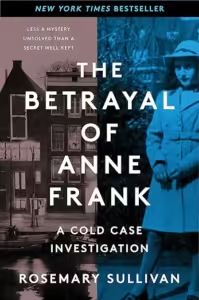The Betrayal of Anne Frank: A Cold Case Investigation
Rosemary Sullivan
Harper Perennial
Published January 17, 2023
Amazon | Bookshop | Goodreads
About The Betrayal of Anne Frank
Using new technology, recently discovered documents and sophisticated investigative techniques, an international team—led by an obsessed former FBI agent—has finally solved the mystery that has haunted generations since World War II: Who betrayed Anne Frank and her family? And why?
More than thirty million people have read The Diary of a Young Girl, the journal teen-aged Anne Frank kept while living in an attic with her family in Amsterdam during World War II, until the Nazis arrested them and sent Anne to her death in a concentration camp. But despite the many works—journalism, books, plays and novels—devoted to Anne’s story, none has ever conclusively explained how the Franks and four other people managed to live in hiding undetected for over two years—and who or what finally brought the Nazis to their door.
With painstaking care, former FBI agent Vincent Pankoke and a team of indefatigable investigators pored over tens of thousands of pages of documents—some never-before-seen—and interviewed scores of descendants of people involved, both Nazi sympathizers and resisters, familiar with the Franks. Utilizing methods developed by the FBI, the Cold Case Team painstakingly pieced together the months leading to the Franks’ arrest—and came to a shocking conclusion.
The Betrayal of Anne Frank is their riveting story. Rosemary Sullivan introduces us to the investigators, explains the behavior of both the captives and their captors and profiles a group of suspects. All the while, she vividly brings to life wartime Amsterdam: a place where no matter how wealthy, educated, or careful you were, you never knew whom you could trust.
International Holocaust Remembrance Day
Today, January 27, is International Holocaust Remembrance Day. While it’s important to listen and learn about the Holocaust and the events that led to those horrors throughout the year, this is a day we designate to specifically pause and remember.
My Review of The Betrayal of Anne Frank: A Cold Case Investigation
This incredible book blew me away. Initially, I listened to the audiobook, but I needed to read passages in the ebook version alongside the audio version because there was so much compelling information presented. I sometimes read ahead in the ebook and then listened to the audiobook, too. I found having both helped me grasp the content.
Sullivan does a great job laying out the cold case investigation with orderliness and precision. She also orients readers to the importance of the quest by offering context about the Netherlands in the 1930s and 1940s as well as information about the Frank family and Otto Frank’s life after the war.
Some of the things the author describes are genuinely heartbreaking. The one that hit me the hardest was the description of how Anne Frank’s diary comes into her father’s possession. Another thing that struck me was the way that the people hiding the eight people in the annex lived during the war and the constant danger they risked.
If you enjoy nonfiction about World War II or cold case stories, I can’t recommend this one enough.
Content Notes
Recommended for Ages 16 up.
Profanity/Crude Language Content
None.
Romance/Sexual Content
Very brief mention of Anne’s relationship with Peter van Pels. One of the possible betrayers was a woman known to have romantic relationships with Nazi officers.
Spiritual Content
References to Judaism.
Violent Content
References to deaths caused by World War II and concentration camps. References to antisemitism, racism, and xenophobia.
Drug Content
None.
Note: This post contains affiliate links, which do not cost you anything to use but help support this blog. All opinions are my own.
